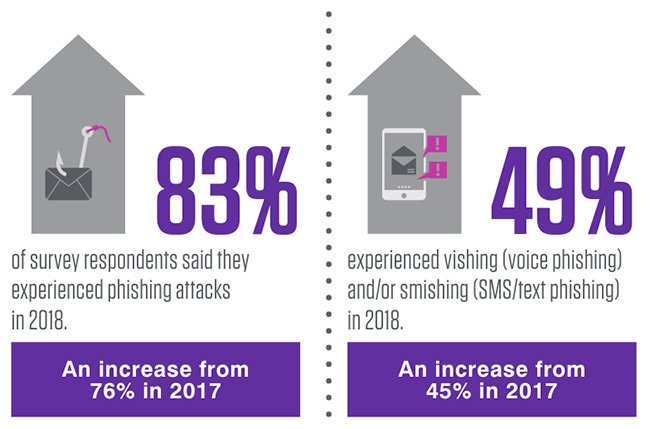83% of global respondents experienced phishing attacks in 2018
Proofpoint analyzed data from tens of millions of simulated phishing attacks sent over a one-year period, along with nearly 15,000 cybersecurity professional survey responses, to provide an in-depth look at state of global phishing attacks.

Overall, 83 percent of global infosecurity respondents experienced phishing attacks in 2018, up from 76 percent in 2017, and nearly 60 percent saw an increase in employee detection following security awareness training. In addition, more organizations were affected by all types of social engineering attacks (phishing, spear phishing, sms phishing, voice phishing, and USB drops) year over year. For the first time, compromised accounts bypassed malware infections as the most commonly identified impact of successful phishing attacks.
“Email is the top cyberattack vector, and today’s cybercriminals are persistently targeting high-value individuals who have privileged access or handle sensitive data within an organization,” said Joe Ferrara, general manager of Security Awareness Training for Proofpoint. “As these threats grow in scope and sophistication, it is critical that organizations prioritize security awareness training to educate employees about cybersecurity best practices and establish a people-centric strategy to defend against threat actors’ unwavering focus on compromising end users.”
This year’s State of the Phish Report key findings include the following:
Infosecurity professionals reported a higher frequency of all types of social engineering attacks year over year. Phishing increased to 83 percent vs. 76 percent. Spear phishing increased to 64 percent from 53 percent. Vishing and/or smishing increased to 49 percent vs. 45 percent, and USB attacks increased to 4 percent vs. 3 percent.
Credential compromise has increased 70 percent since 2017 and 280 percent since 2016, surpassing malware infections to become the most common phishing attack impact in 2018. Respondents reporting phishing attacks, that resulted in data loss, more than tripled between 2016 and 2018, underscoring the growing phishing threat and impact from such attacks.
83 percent of global respondents experienced phishing attacks in 2018, demonstrating a 9 percent year-over-year increase. Only 10 percent of respondents reported experiencing a ransomware attack, confirming that ransomware took a back seat to other types of attacks last year.
59 percent of suspicious emails reported by end users were classified as potential phishing, indicating that employees are being more diligent and thoughtful about the emails they receive.
Baby boomers outperformed all other age groups in fundamental phishing and ransomware knowledge, underscoring why organizations should not assume a younger workforce has an innate awareness of cybersecurity threats.
Educating employees about today’s cyber threats is essential. In a global survey, working adults identified the following terms correctly: phishing (66 percent correct), ransomware (45 percent correct), smishing (23 percent correct), and vishing (18 percent correct). These findings spotlight a knowledge gap when it comes to the language security teams are using when communicating to end users.

“Lack of cybersecurity awareness, in particular amongst the millennial/Generation Z demographic, presents a greater threat than many businesses expect. Our latest research shows that surprisingly, older generational groups can more accurately identify threats such as phishing and ransomware than digitally-savvy millennials. This tells us that millennials, despite being much more comfortable and at ease with digital platforms, display greater complacency towards threats and perceived risks,” said Adenike Cosgrove, Cybersecurity Strategist, EMEA, Proofpoint.